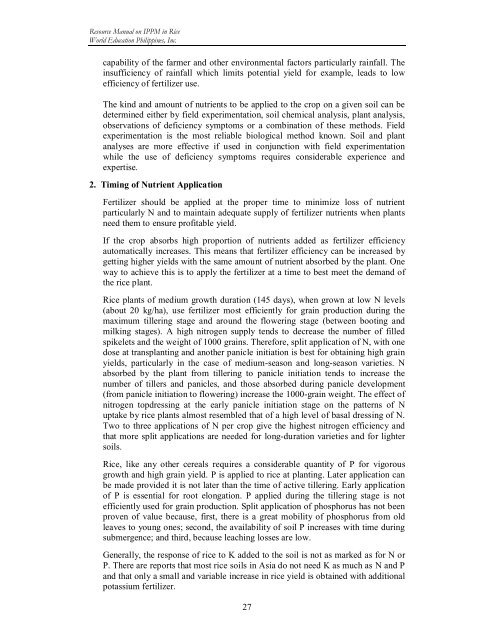(IPPM) in Vegetables - Vegetableipmasia.org
(IPPM) in Vegetables - Vegetableipmasia.org
(IPPM) in Vegetables - Vegetableipmasia.org
You also want an ePaper? Increase the reach of your titles
YUMPU automatically turns print PDFs into web optimized ePapers that Google loves.
Resource Manual on <strong>IPPM</strong> <strong>in</strong> Rice<br />
World Education Philipp<strong>in</strong>es, Inc.<br />
capability of the farmer and other environmental factors particularly ra<strong>in</strong>fall. The<br />
<strong>in</strong>sufficiency of ra<strong>in</strong>fall which limits potential yield for example, leads to low<br />
efficiency of fertilizer use.<br />
The k<strong>in</strong>d and amount of nutrients to be applied to the crop on a given soil can be<br />
determ<strong>in</strong>ed either by field experimentation, soil chemical analysis, plant analysis,<br />
observations of deficiency symptoms or a comb<strong>in</strong>ation of these methods. Field<br />
experimentation is the most reliable biological method known. Soil and plant<br />
analyses are more effective if used <strong>in</strong> conjunction with field experimentation<br />
while the use of deficiency symptoms requires considerable experience and<br />
expertise.<br />
2. Tim<strong>in</strong>g of Nutrient Application<br />
Fertilizer should be applied at the proper time to m<strong>in</strong>imize loss of nutrient<br />
particularly N and to ma<strong>in</strong>ta<strong>in</strong> adequate supply of fertilizer nutrients when plants<br />
need them to ensure profitable yield.<br />
If the crop absorbs high proportion of nutrients added as fertilizer efficiency<br />
automatically <strong>in</strong>creases. This means that fertilizer efficiency can be <strong>in</strong>creased by<br />
gett<strong>in</strong>g higher yields with the same amount of nutrient absorbed by the plant. One<br />
way to achieve this is to apply the fertilizer at a time to best meet the demand of<br />
the rice plant.<br />
Rice plants of medium growth duration (145 days), when grown at low N levels<br />
(about 20 kg/ha), use fertilizer most efficiently for gra<strong>in</strong> production dur<strong>in</strong>g the<br />
maximum tiller<strong>in</strong>g stage and around the flower<strong>in</strong>g stage (between boot<strong>in</strong>g and<br />
milk<strong>in</strong>g stages). A high nitrogen supply tends to decrease the number of filled<br />
spikelets and the weight of 1000 gra<strong>in</strong>s. Therefore, split application of N, with one<br />
dose at transplant<strong>in</strong>g and another panicle <strong>in</strong>itiation is best for obta<strong>in</strong><strong>in</strong>g high gra<strong>in</strong><br />
yields, particularly <strong>in</strong> the case of medium-season and long-season varieties. N<br />
absorbed by the plant from tiller<strong>in</strong>g to panicle <strong>in</strong>itiation tends to <strong>in</strong>crease the<br />
number of tillers and panicles, and those absorbed dur<strong>in</strong>g panicle development<br />
(from panicle <strong>in</strong>itiation to flower<strong>in</strong>g) <strong>in</strong>crease the 1000-gra<strong>in</strong> weight. The effect of<br />
nitrogen topdress<strong>in</strong>g at the early panicle <strong>in</strong>itiation stage on the patterns of N<br />
uptake by rice plants almost resembled that of a high level of basal dress<strong>in</strong>g of N.<br />
Two to three applications of N per crop give the highest nitrogen efficiency and<br />
that more split applications are needed for long-duration varieties and for lighter<br />
soils.<br />
Rice, like any other cereals requires a considerable quantity of P for vigorous<br />
growth and high gra<strong>in</strong> yield. P is applied to rice at plant<strong>in</strong>g. Later application can<br />
be made provided it is not later than the time of active tiller<strong>in</strong>g. Early application<br />
of P is essential for root elongation. P applied dur<strong>in</strong>g the tiller<strong>in</strong>g stage is not<br />
efficiently used for gra<strong>in</strong> production. Split application of phosphorus has not been<br />
proven of value because, first, there is a great mobility of phosphorus from old<br />
leaves to young ones; second, the availability of soil P <strong>in</strong>creases with time dur<strong>in</strong>g<br />
submergence; and third, because leach<strong>in</strong>g losses are low.<br />
Generally, the response of rice to K added to the soil is not as marked as for N or<br />
P. There are reports that most rice soils <strong>in</strong> Asia do not need K as much as N and P<br />
and that only a small and variable <strong>in</strong>crease <strong>in</strong> rice yield is obta<strong>in</strong>ed with additional<br />
potassium fertilizer.<br />
27




![Section 4 [ PDF file, 252 KB] - The Field Alliance](https://img.yumpu.com/51387260/1/158x260/section-4-pdf-file-252-kb-the-field-alliance.jpg?quality=85)












